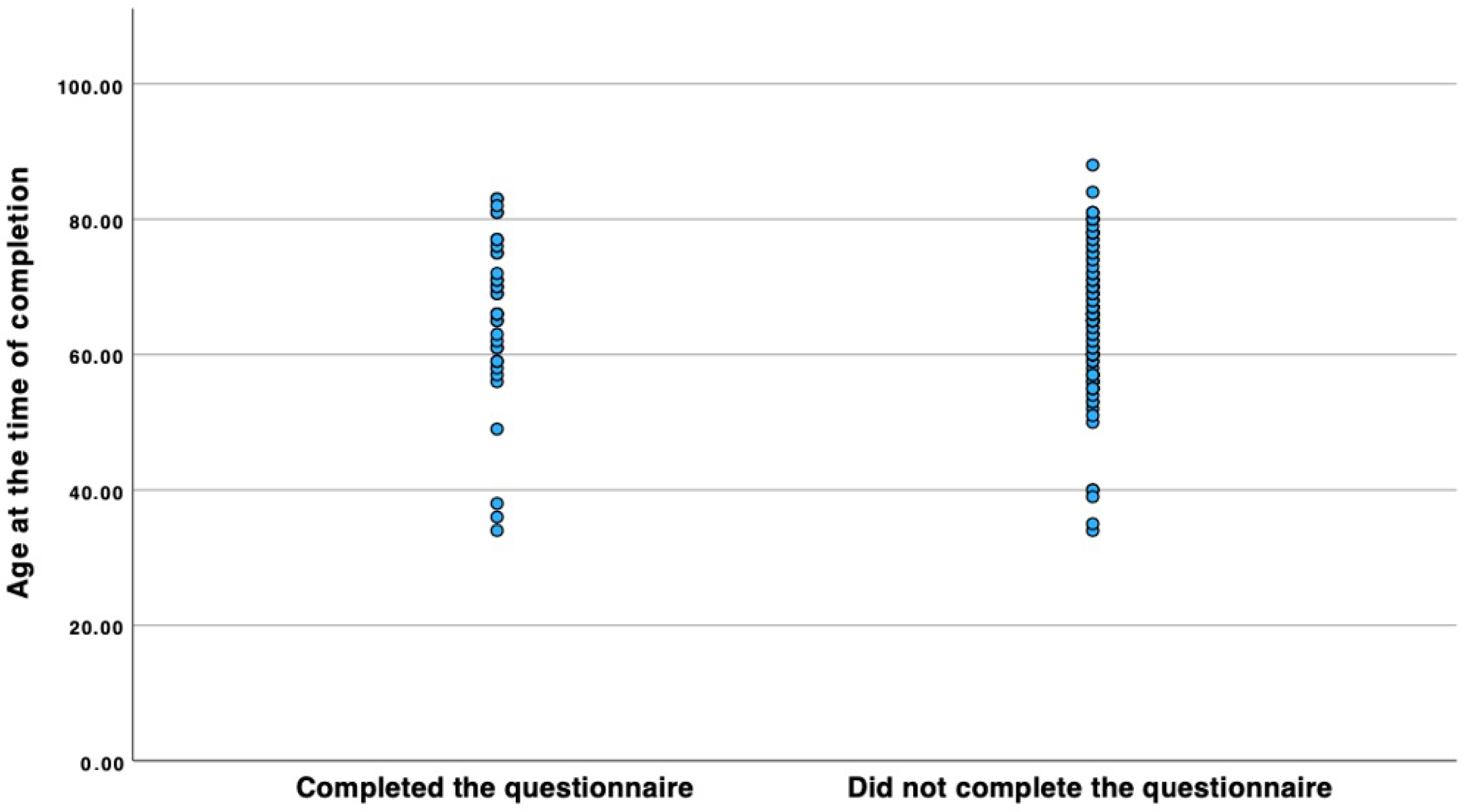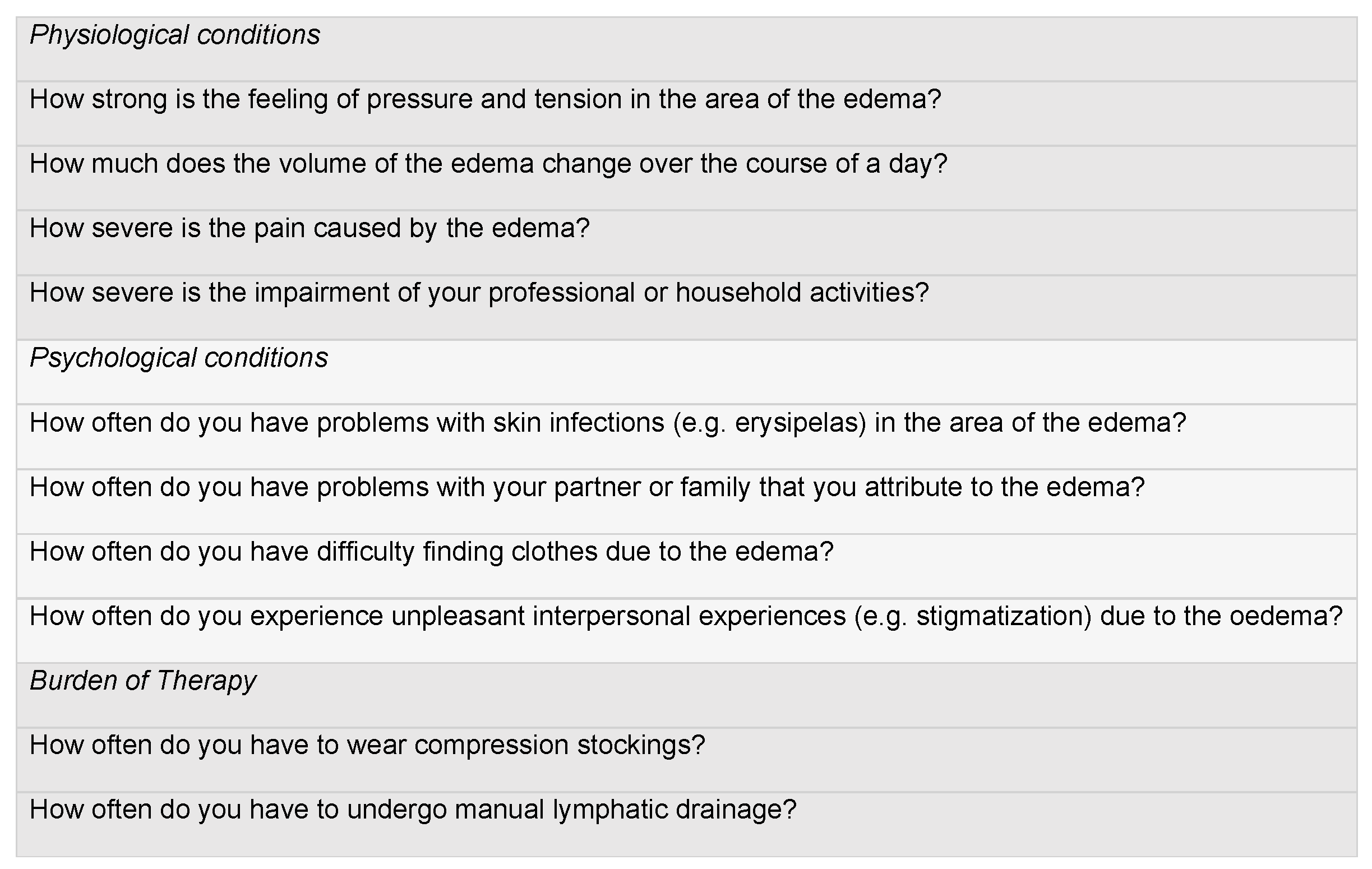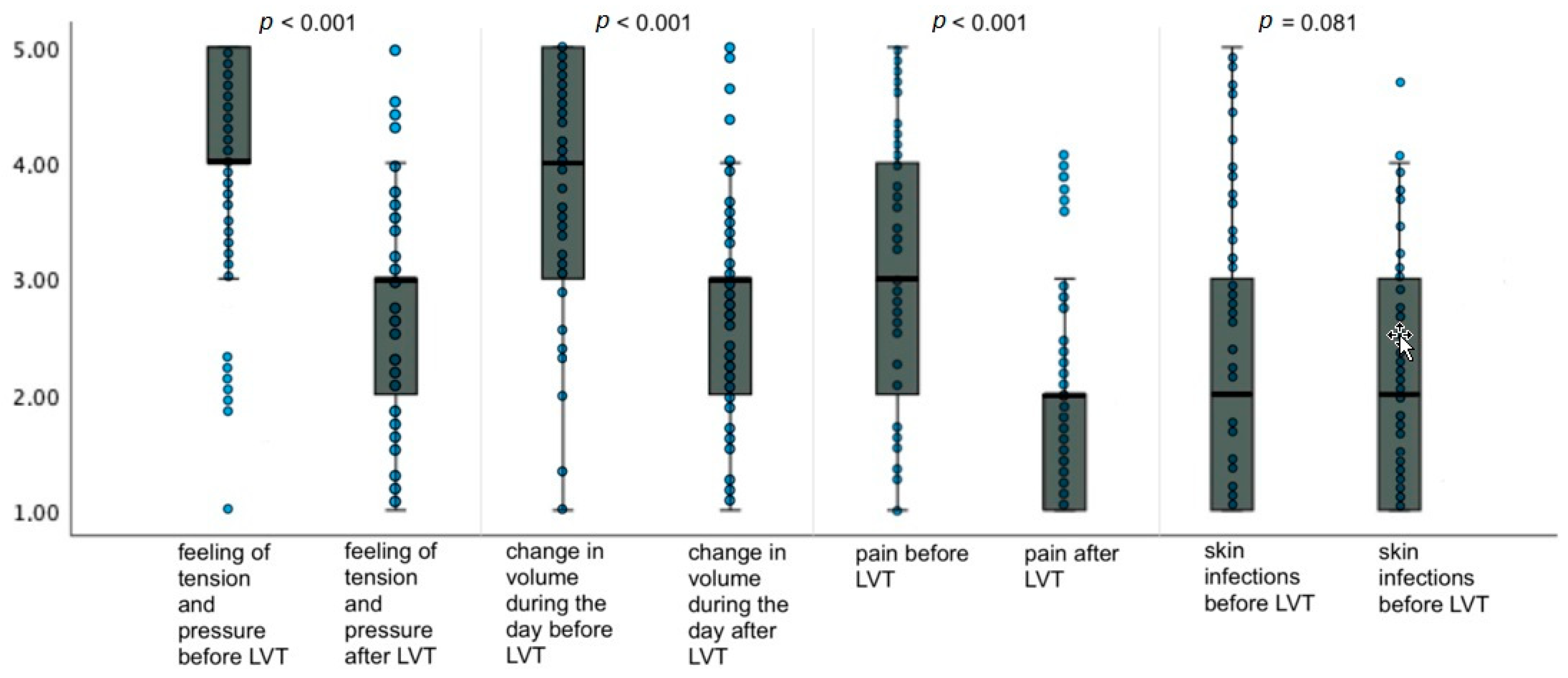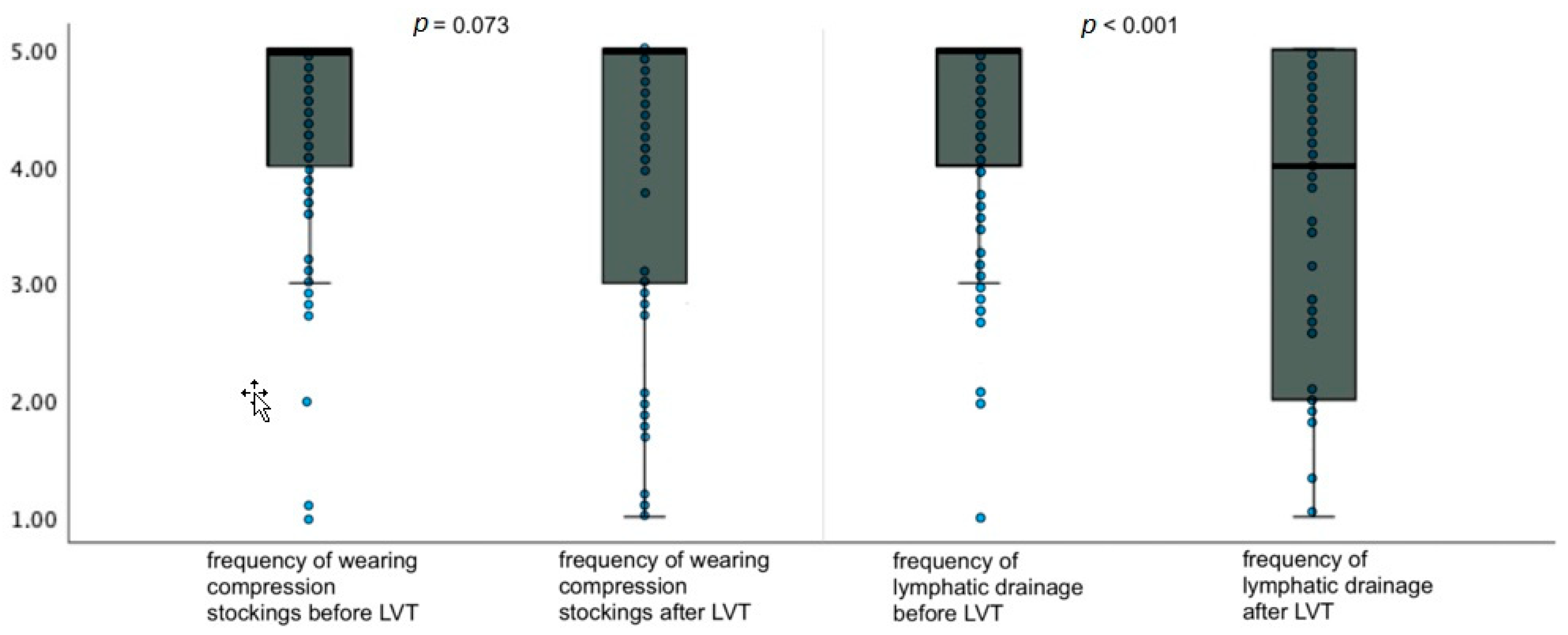Quality of Life in Lymphedema Patients Treated by Microsurgical Lymphatic Vessel Transplantation—A Long-Term Follow-Up
Abstract
1. Introduction
2. Material and Methods
Assessment Instrument
3. Results
3.1. Physiological Conditions
3.2. Psychological Conditions
3.3. Burden of Therapy
4. Discussion
Summary of Results and Interpretation
5. Conclusions and Implications for Further Research
Author Contributions
Funding
Institutional Review Board Statement
Informed Consent Statement
Data Availability Statement
Acknowledgments
Conflicts of Interest
References
- Null, M.; Arbor, T.C.; Agarwal, M. Anatomy, Lymphatic System. 2023 Mar 6. In StatPearls [Internet]; StatPearls Publishing: Treasure Island, FL, USA, 2024. [Google Scholar] [PubMed]
- Ellis, S. Structure and function of the lymphatic system: An overview. Br. J. Community Nurs. 2006, 11, S4–S6. [Google Scholar] [CrossRef] [PubMed]
- Ozdowski, L.; Gupta, V. Physiology, Lymphatic System. 2023 May 1. In StatPearls [Internet]; StatPearls Publishing: Treasure Island, FL, USA, 2024. [Google Scholar] [PubMed]
- Mehrara, B.J.; Radtke, A.J.; Randolph, G.J.; Wachter, B.T.; Greenwel, P.; Rovira, I.I.; Galis, Z.S.; Muratoglu, S.C. The emerging importance of lymphatics in health and disease: An NIH workshop report. J. Clin. Investig. 2023, 133, e171582. [Google Scholar] [CrossRef] [PubMed] [PubMed Central]
- Casley-Smith, J.R.; Földi, M. Lymphangiology, 1st ed.; Schattauer Verlag: Stuttgart, Germany, 1987; pp. 107–122. [Google Scholar]
- Sung, C.; Wang, S.; Hsu, J.; Yu, R.; Wong, A.K. Current Understanding of Pathological Mechanisms of Lymphedema. Adv. Wound Care (New Rochelle) 2022, 11, 361–373. [Google Scholar] [CrossRef] [PubMed] [PubMed Central]
- Brix, B.; Sery, O.; Onorato, A.; Ure, C.; Roessler, A.; Goswami, N. Biology of Lymphedema. Biology 2021, 10, 261. [Google Scholar] [CrossRef] [PubMed] [PubMed Central]
- Flores, T.; Bergmeister, K.D.; Staudenherz, A.; Pieber, K.; Schrögendorfer, K.F. Diagnostik, Prävention und Therapie des Lymphödems [Diagnosis, prevention and therapy of lymphedema]. Wien Klin Wochenschr 2021, 133, 855–868. (In German) [Google Scholar] [CrossRef] [PubMed] [PubMed Central]
- Sleigh, B.C.; Manna, B. Lymphedema. In StatPearls [Internet]; StatPearls Publishing: Treasure Island, FL, USA, 2024. Available online: https://www.ncbi.nlm.nih.gov/books/NBK537239/ (accessed on 26 July 2024). [PubMed]
- Zvonik, M.; Foldi, E.; Felmerer, G. The effects of reduction operation with genital lymphedema on the frequency of erysipelas and the quality of life. Lymphology 2011, 44, 121–130. [Google Scholar] [PubMed]
- Földi, E.; Baumeister, R.G.H.; Bräutigam, P.; Tiedjen, K.U. Zur Diagnostik und Therapie des Lymphödems. Deutsches Ärzteblatt 1998, 95, A-740/B-605/C-565. Available online: https://www.aerzteblatt.de/archiv/10185/Zur-Diagnostik-und-Therapie-des-Lymphoedems (accessed on 26 July 2024).
- Földi, E. Physiology and pathopathology of the lymphatic system. In Földi's Textbook of Lymphology, 2nd ed.; Elsevier: Munich, Germany, 2006. [Google Scholar]
- Jäger, G.; Döller, W.; Roth, R. Quality-of-life and body impairments in patients with lymphedema. Lymphology 2006, 39, 193–200. [Google Scholar] [PubMed]
- Ton, T.G.; Mackenzie, C.; Molyneux, D.H. The burden of mental health in lymphatic filariasis. Infect Dis Poverty. 2015, 4, 34. [Google Scholar] [CrossRef] [PubMed] [PubMed Central]
- Son, A.; O'Donnell, T.F., Jr.; Izhakoff, J.; Gaebler, J.A.; Niecko, T.; Iafrati, M.A. Lymphedema-associated comorbidities and treatment gap. J. Vasc. Surg. Venous Lymphat. Disord. 2019, 7, 724–730. [Google Scholar] [CrossRef] [PubMed]
- Reißhauer, A.; Schuester, L.; Kling, A.; Liebl, M.E. Prävalenz von Komorbiditäten bei Lymphödemerkrankungen. Available online: https://www.thieme-connect.com/products/ejournals/pdf/10.1055/a-0885-1868.pdf (accessed on 26 July 2024).
- Gallagher, K.; Marulanda, K.; Gray, S. Surgical intervention for lymphedema. Surg. Oncol. Clin. N. Am. 2018, 27, 195–215. [Google Scholar] [CrossRef]
- Rabe, E.; Pannier-Fischer, F.; Bromen, K.; Schuldt, K.; Stang, A.; Pancar, C.; Wittenhorst, M.; Bock, E.; Weber, S.; Jöckel, K.H. Bonner Venenstudie der Deutschen Gesellschaft für Phlebologie: Epidemiologische Untersuchung zur Frage der Häufigkeit und Ausprägung von chronischen Venenkrankheiten in der städtischen und ländlichen Wohnbevölkerung. Available online: https://www.eurocom-info.de/fileadmin/freigabe/user_upload/Dokumente_eurocom/pdf_Dokumente_eurocom/Bonner_Venenstudie.pdf (accessed on 26 July 2024).
- Anuszkiewicz, K.; Jankau, J.; Kur, M. What do we know about treating breast-cancer-related lymphedema? Review of the current knowledge about therapeutic options. Breast Cancer 2023, 30, 187–199. [Google Scholar] [CrossRef] [PubMed] [PubMed Central]
- Baumeister, R.G.H. Reconstructive Lymph Vascular Surgery. 2. Auflage, München; Springer International Publishing: Berlin/Heidelberg, Germany, 2017. [Google Scholar] [CrossRef]
- Garza, R., 3rd; Skoracki, R.; Hock, K.; Povoski, S.P. A comprehensive overview on the surgical management of secondary lymphedema of the upper and lower extremities related to prior oncologic therapies. BMC Cancer 2017, 17, 468. [Google Scholar] [CrossRef] [PubMed] [PubMed Central]
- Baumeister, R.G.H.; Frick, A. The microsurgical lymph vessel transplantation. Plastic Surgery 2003, 35, 202–209. [Google Scholar]
- Baumeister, R.G.H.; Weiss, M.; Notohamiprodjo, M.; Wallmichrath, J.; Springer, S.; Frick, A. Microsurgical Lymphatic Vessel Transplantation. J. Reconstr. Microsurg. 2016, 32, 34–41. [Google Scholar] [PubMed]
- Felmerer, G.; Sattler, T.; Lohrmann, C.; Tobbia, D. Treatment of various secondary lymphoedemas by microsurgical lymph vessel transplantation. Microsurgery 2012, 32, 171–177. [Google Scholar] [CrossRef] [PubMed]
- Springer, S.; Koller, M.; Baumeister, R.G.H.; Frick, A. Changes in quality of life of patients with lymphedema after lymphatic vessel transplantation. Lymphology 2011, 44, 65–71. [Google Scholar]
- Bulley, C.; Gaal, S.; Coutts, F.; Blyth, C.; Jack, W.; Chetty, U.; Barber, M.; Tan, C.W. Comparison of breast cancer-related lymphedema (upper limb swelling) prevalence estimated using objective and subjective criteria and relationship with quality of life. Biomed. Res. Int. 2013, 2013, 807569. [Google Scholar] [CrossRef]
- Klernas, P.; Johnsson, A.; Boyages, J.; Brorson, H.; Munnoch, A.; Johansson, K. Test of responsiveness and sensitivity of the questionnaire ‘lymphedema quality of life inventory’. Lymphat. Res. Biol. 2018, 16, 300–308. [Google Scholar] [CrossRef]
- Henderson, W.G.; Meguid, R.A.; Lambert-Kerzner, A.; Bronsert, M.R.; Hammermeister, K.E. A Pilot Study of Patient-Reported Outcome Measures Across a Broad Sample of Surgical Patients. J. Surg. Res. 2021, 259, 342–349. [Google Scholar] [CrossRef] [PubMed]
- Churruca, K.; Pomare, C.; Ellis, L.A.; Long, J.C.; Henderson, S.B.; Murphy, L.E.D.; Leahy, C.J.; Braithwaite, J. Patient-reported outcome measures (PROMs): A review of generic and condition-specific measures and a discussion of trends and issues. Health Expect. 2021, 24, 1015–1024. [Google Scholar] [CrossRef] [PubMed] [PubMed Central]
- Chow, A.; Mayer, E.K.; Darzi, A.W.; Athanasiou, T. Patient-reported outcome measures: The importance of patient satisfaction in surgery. Surgery 2009, 146, 435–443. [Google Scholar] [CrossRef] [PubMed]
- Mercier, G.; Pastor, J.; Moffatt, C.; Franks, P.; Quéré, I. LIMPRINT: Health-Related Quality of Life in Adult Patients with Chronic Edema. Lymphat. Res. Biol. 2019, 17, 163–167. [Google Scholar] [CrossRef] [PubMed] [PubMed Central]
- Ridner, S.H. The psycho-social impact of lymphedema. Lymphat Res. Biol. 2009, 7, 109–112. Available online: https://www.ncbi.nlm.nih.gov/pmc/articles/PMC2904185/#:~:text=Specifically%2C%20loss%20of%20confidence%20in,different%20in%20the%20lymphedema%20arms (accessed on 26 July 2024). [CrossRef] [PubMed] [PubMed Central]
- Moffatt, C.J.; Franks, P.J.; Doherty, D.C.; Williams, A.F.; Badger, C.; Jeffs, E.; Bosanquet, N.; Mortimer, P.S. Lymphoedema: An underestimated health problem. QJM 2003, 96, 731–738. [Google Scholar] [CrossRef] [PubMed]
- Meuli, J.N.; Guiotto, M.; Elmers, J.; Mazzolai, L.; Di Summa, P.G. Outcomes after microsurgical treatment of lymphedema: A systematic review and meta-analysis. Int. J. Surg. 2023, 109, 1360–1372. [Google Scholar] [CrossRef] [PubMed] [PubMed Central]
- Lim, P.; Li, H.; Neoh, D.; Ng, S.K. Health-related Quality of Life Measurement Tools for Lymphedema: A Review of the Literature. Plast. Reconstr. Surg. Glob. Open 2022, 10, e4276. [Google Scholar] [CrossRef] [PubMed] [PubMed Central]
- Tang, N.S.J.; Ramakrishnan, A.; Shayan, R. Quality-of-life outcomes after operative management of primary and secondary lymphoedema: A systematic review. ANZ J. Surg. 2021, 91, 2624–2636. [Google Scholar] [CrossRef] [PubMed]
- Costa, D.; Ielapi, N.; Bevacqua, E.; Ciranni, S.; Cristodoro, L.; Torcia, G.; Serra, R. Social Determinants of Health and Vascular Diseases: A Systematic Review and Call for Action. Soc. Sci. 2023, 12, 214. [Google Scholar] [CrossRef]
- Braveman, P.; Gottlieb, L. The social determinants of helath: It’s time to consider the causes of the causes. Public Health Rep. 2014, 129 (Suppl. S2), 19–31. [Google Scholar] [CrossRef] [PubMed] [PubMed Central]
- Menrath, I.; Gminder, A.; Hiort, O.; Thyen, U. Gesundheitsbezogene Lebensqualität, Selbstwert und Gesundheitsverhalten durchschnittlich 6 Jahre nach einem ambulanten Adipositastherapieprogramm [Health Related Quality of Life, Self-Esteem and Health Behaviour on Average 6 Years after an Obesity Lifestyle Program]. Klin Padiatr. 2017, 229, 216–222. (In German) [Google Scholar] [CrossRef] [PubMed]







| Patients Who Completed the Questionnaire | Patients Who Did Not Complete the Questionnaire | Total | |
|---|---|---|---|
| Male | 7 | 29 | 36 |
| Female | 28 | 125 | 153 |
| Total | 35 | 154 | 189 |
| p-value | p = 0.87 | ||
| Patients Who Completed the Questionnaire | Patients Who Did Not Complete the Questionnaire | Total | |
|---|---|---|---|
| Primary lymphoedema | 6 | 23 | 29 |
| Secondary lymphoedema | 29 | 131 | 160 |
| Mammary carcinoma | 19 | 61 | 80 |
| Cervical carcinoma | 6 | 32 | 38 |
| Ovarian carcinoma | 1 | 13 | 14 |
| Malignant melanoma | 1 | 6 | 7 |
| M. Hodgkin | 0 | 3 | 3 |
| Other malignant tumors | 0 | 6 | 6 |
| Idiomatic genesis | 0 | 5 | 5 |
| Traumatic genesis | 1 | 3 | 4 |
| Total | 35 | 154 | 189 |
| p-value | p = 0.651 | ||
| Gender | Primary Diagnosis | Age at Time of Death | Age at Time of Diagnosis | Survival Since Diagnosis | Age at Time of Surgery | Survival Since Surgery |
|---|---|---|---|---|---|---|
| f | Ovarian carcinoma | 56 | 45 | 11 | 47 | 9 |
| m | Traumatic genesis | 51 | 24 | 27 | 26 | 25 |
| f | Mammary carcinoma | 56 | 41 | 15 | 44 | 12 |
| f | Mammary carcinoma | 73 | 53 | 20 | 55 | 18 |
| f | Mammary carcinoma | 63 | 49 | 14 | 53 | 10 |
| f | Ovarian carcinoma | 64 | 43 | 21 | 47 | 17 |
| f | Mammary carcinoma | 58 | 38 | 20 | 42 | 16 |
| f | Mammary carcinoma | 65 | 46 | 19 | 49 | 16 |
| f | Mammary carcinoma | 62 | 43 | 19 | 47 | 15 |
| f | Cervical carcinoma | 58 | 44 | 14 | 47 | 11 |
| f | Mammary carcinoma | 75 | 51 | 24 | 55 | 20 |
| f | Mammary carcinoma | 52 | 39 | 13 | 43 | 9 |
| f | Cervical carcinoma | 51 | 35 | 16 | 39 | 12 |
| f | Endometrial carcinoma | 62 | 41 | 21 | 47 | 15 |
| f | Cervical carcinoma | 58 | 37 | 21 | 47 | 11 |
| f | Mammary carcinoma | 77 | 47 | 30 | 49 | 28 |
| f | Mammary carcinoma | 73 | 46 | 27 | 49 | 24 |
| m | Primary lymphoedema | 59 | 22 | 37 | 36 | 23 |
| m | Ewing`s sarcoma | 48 | 24 | 24 | 37 | 11 |
| f | Primary lymphoedema | 53 | 19 | 34 | 34 | 19 |
| f | Mammary carcinoma | 69 | 57 | 12 | 62 | 7 |
| f | Mammary carcinoma | 72 | 48 | 24 | 52 | 20 |
| f | Mammary carcinoma | 71 | 51 | 20 | 53 | 18 |
| m | Malignant melanoma | 82 | 76 | 6 | 77 | 5 |
| f | Mammary carcinoma | 78 | 69 | 9 | 74 | 4 |
| f | Mammary carcinoma | 69 | 39 | 30 | 53 | 16 |
| f | Ovarian carcinoma | 77 | 71 | 6 | 73 | 4 |
| f | Mammary carcinoma | 79 | 55 | 24 | 60 | 19 |
| f | Mammary carcinoma | 93 | 65 | 28 | 72 | 21 |
| f | Mammary carcinoma | 67 | 53 | 14 | 58 | 9 |
| f | Mammary carcinoma | 86 | 63 | 23 | 75 | 11 |
| f | Malignant melanoma | 79 | 51 | 28 | 54 | 25 |
| f | Mammary carcinoma | 76 | 61 | 15 | 64 | 12 |
| f | Mammary carcinoma | 71 | 47 | 24 | 51 | 20 |
| f | Mammary carcinoma | 75 | 63 | 12 | 69 | 6 |
| f | Mammary carcinoma | 65 | 49 | 16 | 52 | 13 |
| f | Mammary carcinoma | 83 | 64 | 19 | 73 | 10 |
| f | Mammary carcinoma | 68 | 47 | 21 | 50 | 18 |
| f | Mammary carcinoma | 77 | 60 | 17 | 65 | 12 |
| m | Primary lymphoedema | 78 | 21 | 57 | 36 | 42 |
| f | Mammary carcinoma | 80 | 62 | 18 | 71 | 9 |
| f | Idiomatic genesis | 84 | 35 | 49 | 52 | 32 |
| f | Mammary carcinoma | 89 | 53 | 36 | 56 | 33 |
| f | Mammary carcinoma | 71 | 56 | 15 | 58 | 13 |
Disclaimer/Publisher’s Note: The statements, opinions and data contained in all publications are solely those of the individual author(s) and contributor(s) and not of MDPI and/or the editor(s). MDPI and/or the editor(s) disclaim responsibility for any injury to people or property resulting from any ideas, methods, instructions or products referred to in the content. |
© 2024 by the authors. Licensee MDPI, Basel, Switzerland. This article is an open access article distributed under the terms and conditions of the Creative Commons Attribution (CC BY) license (https://creativecommons.org/licenses/by/4.0/).
Share and Cite
Hock, L.A.; Nürnberger, T.; Koban, K.C.; Wiggenhauser, P.S.; Giunta, R.; Demmer, W. Quality of Life in Lymphedema Patients Treated by Microsurgical Lymphatic Vessel Transplantation—A Long-Term Follow-Up. Life 2024, 14, 957. https://doi.org/10.3390/life14080957
Hock LA, Nürnberger T, Koban KC, Wiggenhauser PS, Giunta R, Demmer W. Quality of Life in Lymphedema Patients Treated by Microsurgical Lymphatic Vessel Transplantation—A Long-Term Follow-Up. Life. 2024; 14(8):957. https://doi.org/10.3390/life14080957
Chicago/Turabian StyleHock, Louisa Antonie, Tim Nürnberger, Konstantin Christoph Koban, Paul Severin Wiggenhauser, Riccardo Giunta, and Wolfram Demmer. 2024. "Quality of Life in Lymphedema Patients Treated by Microsurgical Lymphatic Vessel Transplantation—A Long-Term Follow-Up" Life 14, no. 8: 957. https://doi.org/10.3390/life14080957
APA StyleHock, L. A., Nürnberger, T., Koban, K. C., Wiggenhauser, P. S., Giunta, R., & Demmer, W. (2024). Quality of Life in Lymphedema Patients Treated by Microsurgical Lymphatic Vessel Transplantation—A Long-Term Follow-Up. Life, 14(8), 957. https://doi.org/10.3390/life14080957







